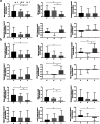Previous exposure to antipsychotic drug treatment is an effective predictor of metabolic disturbances experienced with current antipsychotic drug treatments
- PMID: 35313842
- PMCID: PMC8935760
- DOI: 10.1186/s12888-022-03853-y
Previous exposure to antipsychotic drug treatment is an effective predictor of metabolic disturbances experienced with current antipsychotic drug treatments
Abstract
Background: Antipsychotic drugs are associated with adverse events, but serious side effects are not frequent. This study aimed to ascertain whether previous exposure to antipsychotic treatment was associated with metabolic disturbances induced by current antipsychotic medication.
Methods: A total of 115 antipsychotic-naïve patients, 65 patients with previous exposure to low-metabolic-risk antipsychotics, and 88 patients with previous exposure to high-metabolic-risk antipsychotics were enrolled in our case-control study. All patients were administered olanzapine. Body weight, body mass index (BMI), biochemical indicators of blood glucose and lipids, the proportion of patients who gained more than 7% of their body weight at baseline, and the percentage of dyslipidemia were evaluated. All assessments were conducted at baseline and at 4 and 6 weeks after treatment.
Results: Olanzapine treatment resulted in a significant increase in body weight and BMI in antipsychotic-naïve patients compared with the other two groups (both p < 0.05). However, increases in lipid levels in the high-metabolic-risk antipsychotics group were significantly higher than that in the other two groups (both p < 0.05). A history of antipsychotics use was not associated with weight gain (all p > 0.05). Higher low-density lipoprotein cholesterol ≥3.37 mmol/L-1 was observed in antipsychotics exposure group compared with no history of antipsychotics exposure (aOR, 1.75; 95% CI, 1.07-3.52). Particularly, a history of high-metabolic-risk antipsychotics use was associated with a higher risk of LDL-C ≥3.37 mmol/L-1(aOR, 2.18; 95% CI, 1.03-3.32) compare with other two groups.
Conclusions: A history of exposure to antipsychotics, particularly high-metabolic-risk antipsychotics, is associated with current antipsychotic-induced metabolic disturbances.
Keywords: Antipsychotic; Metabolic side effects; Schizophrenia; Side effects; Weight.
© 2022. The Author(s).
Conflict of interest statement
The authors declare no conflicts of interest.
Figures




Similar articles
-
Atypical antipsychotic drugs cause abnormal glucose and lipid metabolism independent of weight gain.Eur Arch Psychiatry Clin Neurosci. 2025 Apr;275(3):619-627. doi: 10.1007/s00406-025-01965-6. Epub 2025 Feb 19. Eur Arch Psychiatry Clin Neurosci. 2025. PMID: 39969542
-
[Metabolic side effects of risperidone in early onset schizophrenia].Encephale. 2010 Jun;36(3):242-52. doi: 10.1016/j.encep.2009.10.008. Epub 2009 Dec 1. Encephale. 2010. PMID: 20620267 French.
-
A 12-week randomized clinical trial to evaluate metabolic changes in drug-naive, first-episode psychosis patients treated with haloperidol, olanzapine, or risperidone.J Clin Psychiatry. 2007 Nov;68(11):1733-40. doi: 10.4088/jcp.v68n1113. J Clin Psychiatry. 2007. PMID: 18052567 Clinical Trial.
-
Weight gain and changes in metabolic variables following olanzapine treatment in schizophrenia and bipolar disorder.Clin Drug Investig. 2011;31(7):455-82. doi: 10.2165/11589060-000000000-00000. Clin Drug Investig. 2011. PMID: 21495734 Review.
-
[Antipsychotics in bipolar disorders].Encephale. 2004 Sep-Oct;30(5):417-24. doi: 10.1016/s0013-7006(04)95456-5. Encephale. 2004. PMID: 15627046 Review. French.
Cited by
-
The regulatory effects of second-generation antipsychotics on lipid metabolism: Potential mechanisms mediated by the gut microbiota and therapeutic implications.Front Pharmacol. 2023 Jan 25;14:1097284. doi: 10.3389/fphar.2023.1097284. eCollection 2023. Front Pharmacol. 2023. PMID: 36762113 Free PMC article. Review.
-
Which second generation antipsychotic is more associated with metabolic syndrome?Eur Child Adolesc Psychiatry. 2025 Jun 24. doi: 10.1007/s00787-025-02801-x. Online ahead of print. Eur Child Adolesc Psychiatry. 2025. PMID: 40553188 No abstract available.
References
-
- Vancampfort D, Vansteelandt K, Correll CU, Mitchell AJ, De Herdt A, Sienaert P, Probst M, De Hert M. Metabolic syndrome and metabolic abnormalities in bipolar disorder: a meta-analysis of prevalence rates and moderators. Am J Psychiatry. 2013;170(3):265–274. doi: 10.1176/appi.ajp.2012.12050620. - DOI - PubMed
-
- Taipale H, Tanskanen A, Mehtala J, Vattulainen P, Correll CU, Tiihonen J. 20-year follow-up study of physical morbidity and mortality in relationship to antipsychotic treatment in a nationwide cohort of 62,250 patients with schizophrenia (FIN20) World Psychiatry. 2020;19(1):61–68. doi: 10.1002/wps.20699. - DOI - PMC - PubMed
-
- Hert DE, M, Correll CU, Bobes J, Cetkovich-Bakmas M, Cohen D, Asai I, Detraux J, Gautam S, Moller HJ, Ndetei DM, , et al. Physical illness in patients with severe mental disorders I Prevalence, impact of medications and disparities in health care. World Psychiatry. 2011;10(1):52–77. doi: 10.1002/j.2051-5545.2011.tb00014.x. - DOI - PMC - PubMed
Publication types
MeSH terms
Substances
LinkOut - more resources
Full Text Sources
Medical

